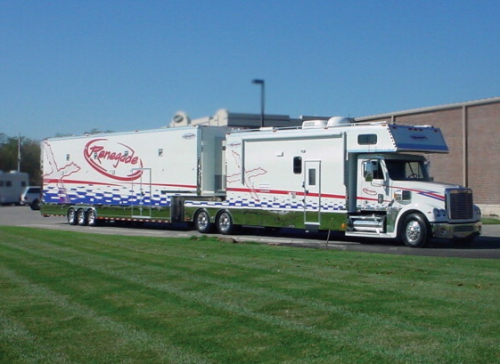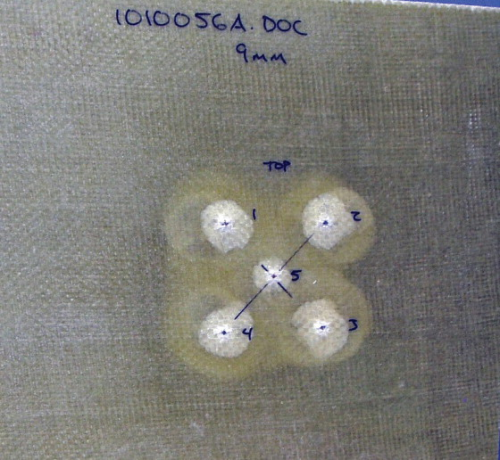

We use a similar fabrication process but for ballistic applications produce panels which are solid fibreglass and resin,” says Fiber-Tech's Vice President of Technology, Bob Pfeifer. “Laminate thicknesses are one-eight-inch to one-and-a-quarter inch (0.32–3.2 cm), depending on the National Institute of Justice (NIJ) ballistic rating required for a given application.”
The NIJ has a rating system for different projectiles or ‘threat levels.’ The higher the rating or threat level, the more resin and reinforcement Fiber-Tech uses in order to produce a thicker ballistic panel. Using glass woven roving in AOC's Altek unsaturated polyester resin, Fiber-Tech's solid ballistic panels have passed NIJ Standards 0108.01 criteria.
Fiber-Tech's largest ballistic panel job so far was the production of ceiling tiles designed to resist mortar shrapnel in soft-sided structures using 0.5-inch (1.3 cm) thick laminates.
From manufacturing sites in Washington, Ohio and Michigan, Fiber-Tech produces large, flat composite panels for the transportation, marine, military, construction, and corrosion resistant markets among others, with transportation as a mainstay. The majority of the composite panels for Penske and U-Haul trucks in the past 18 years were fabricated by Fiber-Tech using Altek unsaturated polyester resin.
“Penske and U-Haul began using composite walls in the late 1980s and have since gone to 100% FRP [fibre reinforced plastic] (instead of aluminium) walls for their consumer rental truck bodies,” explains Wayne Durnin, Fiber-Tech Vice President, Sales.
Fabrication
Fiber-Tech uses Altek resins and Vibrin® gel-coats from AOC to produce large, structural panels using a wet-lay-up process.
Ballistic armour panels made without cores meet NIJ Standards criteria.“We're not just gluing components together,” Durnin says. “We manufacture the entire composite in one complete process to produce a seamless, structural panel, cured under heat and pressure.”
Fiber-Tech uses a closed mould process – a combination of vacuum bagging and infusion. Pfeifer says it is a proven process under the Fiber-Tech name dating back to 1984, but was originally developed in the late 1960s.
Most panels employ a core material, surrounded by composite on both sides. A variety of cores are used including plywood, polypropylene (PP) honeycomb, and several different types of foams. For its ballistic applications, Fiber-Tech uses a solid resin and glass woven roving construction without a core.
Fiber-Tech differentiates itself through its ability to produce very large panels and to do so quickly. The company can fabricate panels up to 11 ft wide and 60 ft long (3.4 m by 18.3 m) for use in truck bodies and architectural applications.
“We build the largest panels in the marketplace so we can maximise the yield from our panels,” Durnin points out. “If a customer needs 4-ft by 8-ft (1.2 m by 2.4 m) panels, we can manufacture parts that are 8 ft by 56 ft (2.4 m by 17 m) and cut them to customers' exact specifications.”
The high reactivity of the Altek resin is another factor in Fiber-Tech's success.
“Our ability to produce a large quantity of panels very quickly is a big advantage,” Durnin says.
“Using a highly reactive resin allows us to manufacture panels with the highest square foot throughput in the industry,” says Pfeifer. “Fiber-Tech is able to exceed the daily capacity of some of our competitors before our morning break!”
Among the properties exhibited by AOC resins and gel-coats Fiber-Tech considers the most critical are the resin's flex, wet out and ease of processing.
“We really wanted to use the same resin in our ballistic applications as we do in our standard products,” explains Pfeifer. “Even when we went to a 30% resin ratio for ballistics, we were able to stick with our established fabrication process and the same Altek resin from AOC.”
“The resins and gel-coats have been very high quality and very consistent,” Pfeifer notes. “Since we began using the AOC products, we've made very few process changes.”
When tech service is needed, AOC brings technical personnel into Fiber-Tech plants, usually to assist with process changes and specific projects in which the company is involved.
“They helped us a lot when we made the switch from standard to low-VOC [volatile organic compound] products,” he continues. “It was a year-long project to get our styrene levels from the mid-30s (percentages) down to the mid 20s. AOC adapted their products to our processes because we don't want to make unnecessary changes,” Pfeifer says.






